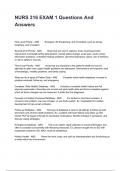NURS 316 EXAM 1 Questions And
Answers
First Level Priority - ANS Emergent, life threatening, and immediate; such as airway,
breathing, and circulation
Second-level Priority - ANS those that are next in urgency- those requiring prompt
intervention to forestall further deterioration; mental status change, acute pain, acute urinary
elimination problems, untreated medical problems, abnormal laboratory values, risk of infection,
or risk to safety or security
Third Level Priority - ANS those that are important to the patient's health but can be
attended to after more urgent health problems are addressed. Interventions are long-term; lack
of knowledge,, mobility problems, and family coping
What are the 4 types of Patient Data - ANS Complete (total health) database, focused or
problem-centered, follow-up, and emergency
Complete (Total Health) Database - ANS Includes a complete health history and full
physical examination. Describes the current and past health state and forms a baseline against
which all future changes can be measured. It yields the first diagnoses.
Focused or Problem-Centered Database - ANS For limited or short-term problem. It
concerns one problem, one cue complex, or one body system. Ex. hospitalized for sudden
development of new-onset confusion.
Follow-up Database - ANS This type of database is used in all settings to follow up both
short-term and chronic health problems. Ex. a patient with heart failure may follow up with
his/her PCP at regular intervals to reevaluate medications, identify changes in symptoms, and
discuss coping strategies.
Emergency Database - ANS This is an urgent, rapid collection of crucial information and
often is compiled concurrently with lifesaving measures. Ex. person brought into an ED with
suspected substance OD. ABCs must be established.
Holistic Health - ANS Views the mind, body, and spirit as interdependent and functioning as
a whole within the environment
, Social Determinants of Health (SDOH) - ANS Factors that influence a person's health and
well-being. Include environment, access to health care, community, education, and economic
stability
What is the 4 basic characteristics of culture? - ANS -learned from birth through the
process of language acquisition and socialization
-shared by all members of the same cultural group
-adapted to specific conditions related to environmental and technical factors and to the
availability of natural resources
-dynamic and ever changing
Ethnicity - ANS a social group that may possess shared traits, such as a common
geographic origin, migratory status, religion, language, values, traditions or symbols, and food
preferences.
Spirituality - ANS a broader term focused on a connection to something larger than oneself
and a belief of transcendence
Religion - ANS an organized system of beliefs concerning the cause, nature, and purpose
of the universe, as well as the attendance of regular services
Subjective Data - ANS What the person says during history taking
Objective Data - ANS What you as the health professional observe by inspecting,
percussing, palpating, and auscultating during the physical examination.
What are the five steps of the nursing process? - ANS Assessment
Diagnosis
Planning
Implementation
Evaluation
Health - ANS Balance of a person, both within one's being (physical, mental, or spiritual)
and in the outside world (natural, communal, or metaphysical).
Cultural Awareness - ANS You must recognize and understand your own culture before
you can work to understand a different culture.
FICA Spiritual History Tool - ANS F- faith and belief (do you consider yourself spiritual or
religious? do you have beliefs that help you deal with stress? what gives your life meaning?)
I- importance (what importance does your faith or belief have in your life?)
C- community
A- address in care




